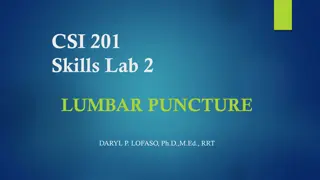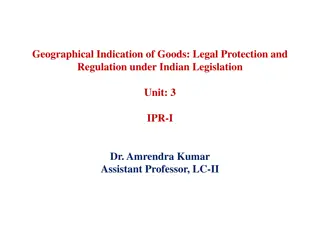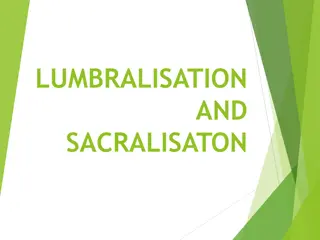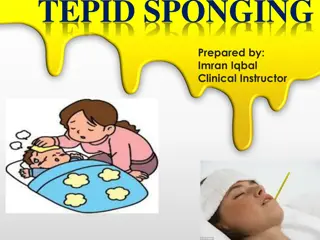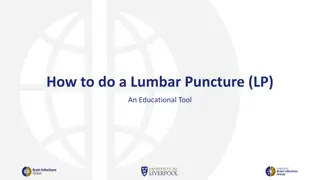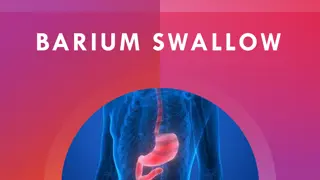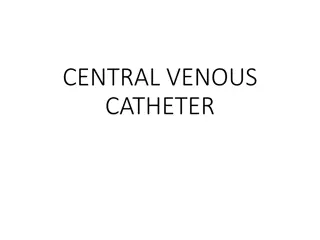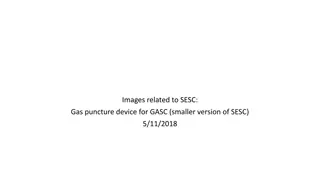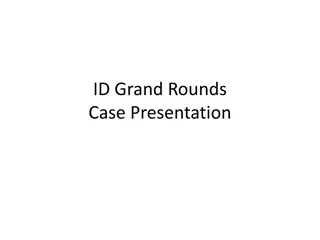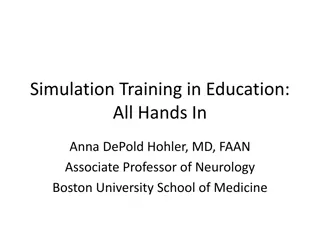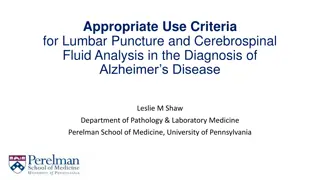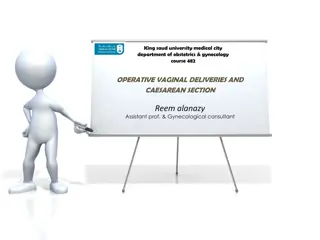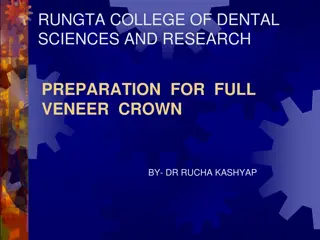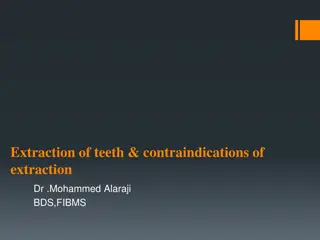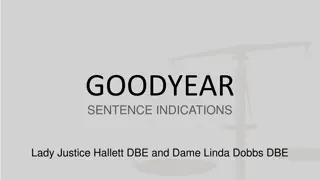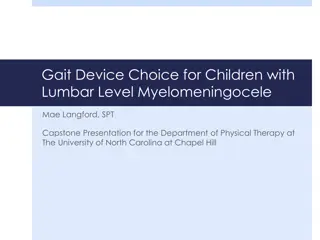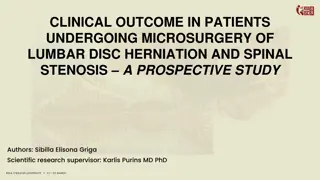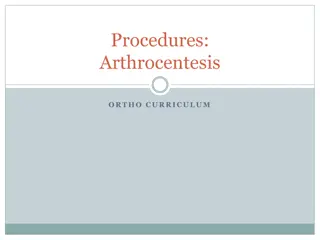Lumbar Puncture: Indications, Contraindications, and Post-procedure Considerations
Lumbar puncture is a medical procedure involving the insertion of a needle into the spinal subarachnoid space to collect cerebrospinal fluid for diagnostic or therapeutic purposes. Indications for performing a lumbar puncture include suspicion of meningitis, subarachnoid hemorrhage, CNS diseases like Guillain-Barre syndrome, and therapeutic relief of conditions like pseudotumor cerebri. Absolute contraindications include infected skin over the needle entry site and unequal pressures between brain compartments. Relative contraindications involve increased intracranial pressure and coagulopathy. Post-procedure complications may include hematoma, headache, nerve puncture, and adhesive arachnoiditis. It is crucial to conduct a neurological examination, imaging, and laboratory tests, explain the procedure and risks to patients, and obtain informed consent before performing a lumbar puncture.
Download Presentation

Please find below an Image/Link to download the presentation.
The content on the website is provided AS IS for your information and personal use only. It may not be sold, licensed, or shared on other websites without obtaining consent from the author. Download presentation by click this link. If you encounter any issues during the download, it is possible that the publisher has removed the file from their server.
E N D
Presentation Transcript
It is a procedure in which a needle is inserted into the spinal subarachnoid space, usually to colect CSF to establish a diagnosis, but it can also be used for therapeutical reasons.
Lumbar puncture should be performed for the following indications: Suspicion of meningitis Suspicion of subarachnoid hemorrhage (SAH) Suspicion of central nervous system (CNS) diseases such as Guillain-Barre syndrome and carcinomatous meningitis Therapeutic relief of pseudotumor cerebri
Absolute contraindications are: the presence of infected skin over the needle entry site the presence of unequal pressures between the supratentorial and infratentorial compartments. Relative contraindications are: Increased intracranial pressure (ICP) Coagulopathy Brain abscess Vertebral deformities
Hematoma postLP headache Before the doctor removes the needle he should reinsert the stylet so as to not clamp a nerve or to have a CSF leak (causing a headache) Nausea Punction of the nerves or spinal cord (weekness, loss of sensation, *paraplegia) Adhesive arachnoiditis
Neurological examination Imaging Laboratory tests Explain the procedure, benefits, risks, complications, and alternative options to the patient or the patient s representative, and obtain a signed informed consent Hydrate so as to avoid a dry tap Organizing your kit Positioning Analgesia-lidocaine *Lorazepam against anxiety *Antibiotics after blood culture, prior to imaging if patient is suspected of having meningitis
Indications for performing brain CT scanning before lumbar puncture in patients with suspected meningitis include the following: Patients who are older than 60 years Patients who are immunocompromised Patients with known CNS lesions Patients who have had a seizure within 1 week of presentation Patients with an abnormal level of consciousness Patients with focal findings on neurologic examination Patients with papilledema seen on physical examination, with clinical suspicion of an elevated ICP Cranial CT scanning should be obtained before lumbar puncture in all patients with suspected SAH Cranial CT scanning should be obtained before lumbar puncture in all patients with suspected SAH
LP can be performed with the patient lying on one side or siting on the bed. The election site for LP is the intervetebral space L3-L4 which can be easily found on the imaginary line that unites the postero-superior iliac crests. In more difficult cases, ultrasound guidance can be used.
LP is performed in a sterile environment: sterile gloves and sterile fields. Povidone-iodine is used to clean the patient s skin. Local anestesia with Lidocaine (injected progresively, layer by layer) It is recommended to wait 10 to 15 minutes after local anestesia (studies showed that patients feel less pain if done so) The needle is inserted with the bevel superiorly oriented. In grown-ups, the doctor moves forward about 4-5 cm until he can feel a release of resistance, meaning that he reached SAS. If the needle is in the correct place, drops of CSF should come out. These are colected, and not vacuumed with a seringe. About 20-30 ml of CSF is collected for tests. The doctor can atach a manometer to measure the CSF presure (N=180 mmHg) The stylet is reinserted and the needle is taken out. It is recommended that the patient should rest in a comfortable position for an hour before standing up.
Cell count Proteins Glucosis Latex aglutination PCR (for Herpes simplex or Enteroviruses) Antibodies( for detecting neurosiphylis or Lyme diseasse) Imunoelectrophoresis Citology Bacterial, fungal, viral cultures Smears
The presence of white blood cells in cerebrospinal fluid is called pleocytosis. The presence of granulocytes is always an abnormal finding. A large number of granulocytes often heralds bacterial meningitis. White cells can also indicate reaction to repeated lumbar punctures, reactions to prior injections of medicines or dyes, central nervous system hemorrhage, leukemia, recent epileptic seizure, or a metastatic tumor. The finding of erythrophagocytosis, where phagocytosed erythrocytes are observed, signifies haemorrhage into the CSF that preceded the lumbar puncture. Therefore, when erythrocytes are detected in the CSF sample, erythrophagocytosis suggests causes other than a traumatic tap, such as intracranial haemorrhage and haemorrhagic herpetic encephalitis
Gram staining may demonstrate bacteria in bacterial meningitis. Microbiological culture is the gold standard for detecting bacterial meningitis. Bacteria, fungi, and viruses can all be cultured by using different techniques.
Gram-stain findings illustrating the presence of (A) white blood cells and a few gram-positive cocci in the cytocentrifuged sediment of the patient's CSF, (B) rare gram-negative cocci (circle) in another field of the Gram stain shown in (A), and (C) many gram-negative cocci and coccobacilli in the Gram- stained smear of a colony from the TSA blood agar culture.
Glucose is present in the CSF; the level is usually about 60% that in the peripheral circulation. Decreased glucose levels can indicate fungal, tuberculous or pyogenic infections; lymphomas; leukemia spreading to the meninges; meningoencephalitic mumps; or hypoglycemia. Increased glucose levels in the fluid can indicate diabetes Increased levels of lactate can occur the presence of cancer of the CNS, multiple sclerosis, heritable mitochondrial disease, low blood pressure, low serum phosphorus, respiratory alkalosis, idiopathic seizures, traumatic brain injury, cerebral ischemia, brain abscess, hydrocephalus, hypocapnia or bacterial meningitis.
Changes in total protein content of cerebrospinal fluid can result from pathologically increased permeability of the blood-cerebrospinal fluid barrier, obstructions of CSF circulation, meningitis, neurosyphilis, brain abscesses, subarachnoid hemorrhage, polio, collagen disease or Guillain-Barr syndrome, leakage of CSF, increases in intracranial pressure or hyperthyroidism. Very high levels of protein may indicate tuberculous meningitis or spinal block. IgG synthetic rate is calculated from measured IgG and total protein levels; it is elevated in immune disorders such as multiple sclerosis, transverse myelitis.
Medscape.com Netter s Neurology Harrison s Neurology in clinical Medicine


